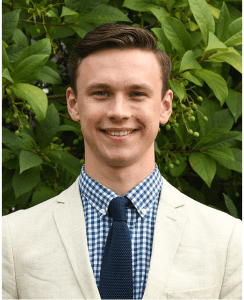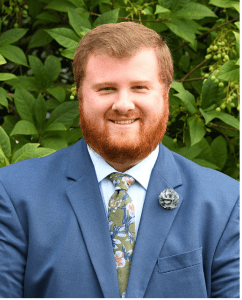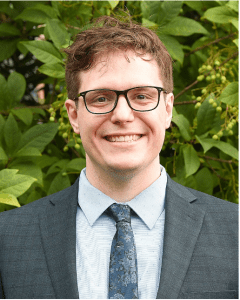2021
Kayle Avery was born and raised in Laramie, Wyoming. In this often- quiet corner of the West, he developed a passion for storytelling. This passion developed into an interest in media and the process of making things. But it was not until Kayle joined the University of Wyoming Geological Museum as a Docent, that he discovered the craft of curation and the power of objects as medium. With his newfound interests, Kayle developed and organized the self-funded Museum and Archive Coalition that paired students with local museums. Kayle also helped lead and develop methods for the CAM-Art Project, which researched national museum collections for looted artifacts from Cambodia. After earning a B.A. in History with a minor in Museum Studies and Asian Studies, Kayle worked at the UW Art Museum as Exhibition Coordinator and the UW Geological Museum as Exhibition Manager. In the following year, the Art Museum promoted Kayle to Assistant Curator where he managed nearly a dozen exhibitions per year, half of which he curated personally. At Winterthur, he is excited to explore the finer points of object research to help him tell better stories in the museum and elsewhere.
 Justyce Bennett
Justyce Bennett
Justyce Bennett was raised in Laurel, Maryland, located just between Washington D.C. and Baltimore. This location allowed her to explore her love of art and history from an early age and shaped her interests in the Atlantic World. Her love of art blossomed when she attended St. Mary’s College of Maryland, where she obtained a B.A. in Art History and Anthropology. St. Mary’s location in southern Maryland was perfect for learning more about the Atlantic World and history. During her time at St. Mary’s she worked at the St. Mary’s Fine Art Collections and completed a study tour in St. Croix, a United States Virgin Island. In St. Croix she completed field work at the Lower Bethlehem site and became keenly aware of the impact imperialism, conquest, and colonialism had on people living in the past and present. This experience ultimately made her passionate about making sure marginalized voices are represented in museum collections and scholarship. She hopes to utilize Winterthur’s collections to further these interests.
 Benét Burton
Benét Burton
Raised in Newark, Delaware, Benét Burton spent her childhood taking frequent family and class trips to Winterthur and other Delaware museums. As an undergraduate at the University of Delaware, she participated in the Ronald E. McNair Post-Baccalaureate Achievement Program and graduated with a B.A. in Anthropology and Museum Studies. Her love of analyzing and sharing the past expanded during her work as an undergraduate researcher for the Colored Conventions Project, a collaborative effort to document and present nineteenth- century Black intellectual life and collective organizing via digital media. Combining her skills in academic research with practical experience, Benét interned with Dr. Adam Fracchia; she helped him create an exhibition on the contributions of nineteenth-century Irish immigrants in Baltimore for the Guinness Open Gate Brewery & Barrel House. At the end of her undergraduate studies, Benét worked with Dr. Anne Bowler and the Creative Vision Factory to create a digital archive of outsider artists. At Winterthur, she looks forward to enhancing her skills in object analysis and exploring the material culture minority communities have created.
 Cara Caputo
Cara Caputo
Growing up outside of Chicago, Cara Caputo developed an early interest in history during her family’s quest to visit every museum and historic house the city had to offer. These experiences shaped her studies at Marquette University, where she graduated summa cum laude with a B.A. in History and Anthropology and a minor in Public History. She conducted independent research on ceramic materials excavated from Chicago’s Bronzeville neighborhood in order to study social hierarchies and consumer patterns. She also explored social history through material culture in her undergraduate thesis, where she analyzed women’s hatpins and their use as self-defensive weapons in early 20th-century America. As an intern at the Milwaukee Public Museum and the Chicago History Museum, she explored how objects can represent both shared and personal histories by developing and presenting public programs. These experiences sparked her passion for using objects to create engaging museum programs and exhibitions. At Winterthur, she hopes to combine historical research with her interest in digital humanities and public history in order to share the power and value of material objects with others.
 Peter Fedoryk
Peter Fedoryk
Peter Fedoryk spent his youth in the suburbs of Connecticut, nose buried in books. It was the power of stories that defined how he approached the world around him. As a history major and art history minor at Villanova University, he came to see archival documents and historic paintings as building blocks with which he could tell new stories. As a collections intern with The Gilder Lehrman Institute of American History, Peter worked with original documents and communed vicariously with the Nation’s Founding and Civil War eras. By writing papers on the distorted legacy of George Henry Durrie’s 19th-century New England snowscapes, and the ways Thomas Cole’s landscape paintings shaped the evolution of environmental movements, Peter learned to tell good stories based on strong scholarship. He subsequently worked as a Research Fellow at the Thomas Cole National Historic Site, and as their Assistant Curator. At Winterthur, Peter looks to add historic objects of all kinds to his intellectual toolkit, as his search for the next story continues.
 Christopher Malone
Christopher Malone
Christopher Malone developed a passion for history of art, architecture, and folk customs while growing up in the Lehigh Valley region of Pennsylvania. He studied architecture and film at the University of Pittsburgh, exploring museums and historic sites on weekends. Christopher completed a master’s in architecture at Syracuse University in 2015. His thesis on architecture’s representation in film and the digital world explored the concept of spatial voyeurism. Trips to antique shops led to a collection of photography and folk art, and he began writing The Daily Antiquarian, a blog on the material culture of the Mid-Atlantic region. While volunteering at the Philadelphia History Museum, he began working at the Moravian Historical Society, eventually becoming the Operations Manager. While there, he focused attention on the Society’s collections through social media. He also volunteered in the collections department at Lehigh University’s Art Galleries, photographing and identifying key themes in their collection of 19th- and 20th-century images. While at Winterthur, he looks forward to studying how objects and architecture relate to cultural and religious ideas of representation.
 Molly Mapstone
Molly Mapstone
Growing up in a small town in Minnesota, Molly Mapstone spent much of her childhood outside playing with her siblings and getting lost by teleporting across time and space by reading anything she could check out at the local library. Pursuing her lifelong passion of exploring museums, Molly began working at the Chazen Museum of Art during her undergraduate career at the University of Wisconsin-Madison. At the Chazen, Molly had the chance to research, teach, and curate from the prints and drawings collection. Through working in the museum directly with objects and taking classes in art history, Molly discovered her passion for material culture. After becoming fluent in French and completing her award-winning thesis, Revealing the Hidden in Plain Sites: Contemporary Ceramic Objects and Political Protest, Molly graduated with honors with a B.A. in art history and French in the spring of 2019. At Winterthur, she looks forward to developing new research interests, and continuing her commitment to close looking and object-centered research.
 Kaila Temple
Kaila Temple
Kaila Temple was born and raised in Berkeley, California, to two STEM career parents. She was always the “opposite” child for her interest in humanities. She developed a deep interest in dress history and material culture, influenced by obsessive viewing of the PBS program Antiques Roadshow with her grandmother. She graduated with high honors in Art History from Smith College, having completed internships at Historic Deerfield, The Colonial Williamsburg Foundation, History San Jose, and the San Jose Museum of Quilts & Textiles. After graduation, she participated in the Historic Deerfield Summer Fellowship, where she focused on stays and staymaking in colonial New England. Most recently, as an intern at Maine Historical Society, she evaluated, cataloged, and mounted items from the costume collection as part of a larger grant project. Her research interests lie in the material and visual culture of dress and fashion in colonial America, but she is an avid collector and wearer of 1930s-1950s vintage clothing, as well as her own creations from vintage patterns.

